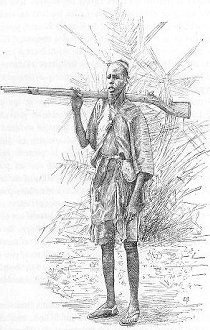|
|

 « Simbo » is one of the most famous songs of the Mandenka traditionist folksongs. « Simbo » is one of the most famous songs of the Mandenka traditionist folksongs.
This tune is also known as « The Anthem of the Bow ».
 Initialy, the « simbo » is the whistle of the Malinke hunter. By metonymy, the word ended up meaning the hunter himself, then
especially « The (Famous) Hunter », SundjataSundiata faasa is the most famous song of the Manding tradition. This song is also known under the title of The
Anthem of the Bow or Simbo... Read more. Initialy, the « simbo » is the whistle of the Malinke hunter. By metonymy, the word ended up meaning the hunter himself, then
especially « The (Famous) Hunter », SundjataSundiata faasa is the most famous song of the Manding tradition. This song is also known under the title of The
Anthem of the Bow or Simbo... Read more.
 Thus, it is not unfair to evoke here an another legendary cause to the link between Sundjata and the epic song of « Simbo »
: indeed, the «simbo» or « soumbo » is still linked to the legendary Mamady Kani [Konate] also called Kanimany (or Kanimane), first mythic king of the new Manding kingdom.
Legend has on it that Kanimany was the son of Bilal, the first Black slave of prophet Mohamad.(1) Thus, it is not unfair to evoke here an another legendary cause to the link between Sundjata and the epic song of « Simbo »
: indeed, the «simbo» or « soumbo » is still linked to the legendary Mamady Kani [Konate] also called Kanimany (or Kanimane), first mythic king of the new Manding kingdom.
Legend has on it that Kanimany was the son of Bilal, the first Black slave of prophet Mohamad.(1)
That man called Bilal(h)l(i), became, at last, the first "muezzin" of the Moslim religion.
 Great hunter and witch-healer, he would have created a special hunting whistle and with that kind of whistle he would
communicated with the savannah genii. Great hunter and witch-healer, he would have created a special hunting whistle and with that kind of whistle he would
communicated with the savannah genii.
 As an expansionist king, he is supposed to have extended the first kingdom of Mali from Sankarani to the Boure, taking over
control on the gold mines for the account of Manding area. As an expansionist king, he is supposed to have extended the first kingdom of Mali from Sankarani to the Boure, taking over
control on the gold mines for the account of Manding area.
 He got three sons, three legendary hunters of the Manding - often recalled in panegyristic songs, Lawali Simbo (alias
Bamari Tanyongon Simbo), Kaninyongo Simbo, and Kani Simbo and they established themselves in the Farakoro area (old Manding). (1) He got three sons, three legendary hunters of the Manding - often recalled in panegyristic songs, Lawali Simbo (alias
Bamari Tanyongon Simbo), Kaninyongo Simbo, and Kani Simbo and they established themselves in the Farakoro area (old Manding). (1)
 Among these three sons, only Kaninyongo Simbo succeed to Kanimany - after the fight for the gold between the heirs. But
according to some others traditional sources, such as Djeli Mamadou Kouyate, the story teller of D.T. NIANE, Sundiata, an Epic of Old Mali, [bibliography]- it was
Bamari Tanyongon Simbo or Lawali Simbo who inherited the throne, succeeding to his father. Among these three sons, only Kaninyongo Simbo succeed to Kanimany - after the fight for the gold between the heirs. But
according to some others traditional sources, such as Djeli Mamadou Kouyate, the story teller of D.T. NIANE, Sundiata, an Epic of Old Mali, [bibliography]- it was
Bamari Tanyongon Simbo or Lawali Simbo who inherited the throne, succeeding to his father.
 However, threee generations after, Bamari Tanyongon Simbo alias Lawali Simbo grandson was born as Nare Maghan Kon Fata
Konate, called Frakro Maghan Keïgni (Maghan « the Beautiful »), the father of SundjataSundiata faasa is the
most famous song of the Manding tradition. This song is also known under the title of The Anthem of the Bow or Simbo... Read more. However, threee generations after, Bamari Tanyongon Simbo alias Lawali Simbo grandson was born as Nare Maghan Kon Fata
Konate, called Frakro Maghan Keïgni (Maghan « the Beautiful »), the father of SundjataSundiata faasa is the
most famous song of the Manding tradition. This song is also known under the title of The Anthem of the Bow or Simbo... Read more.
 That's the reason why, « The Anthem of the Bow » is very close to the tune «SundjataSundiata faasa is the most famous song of the Manding tradition. This song is also known under the title of The Anthem of the Bow or Simbo... Read more [faassa]» ;
indeed, «The Anthem of the Bow» often includes the panegyric (faassa) of the unifier of Manden. That's the reason why, « The Anthem of the Bow » is very close to the tune «SundjataSundiata faasa is the most famous song of the Manding tradition. This song is also known under the title of The Anthem of the Bow or Simbo... Read more [faassa]» ;
indeed, «The Anthem of the Bow» often includes the panegyric (faassa) of the unifier of Manden.
 Famous performers of the song : Famous performers of the song :
| |
Soundioulou Cissokho, Folkore du Sénégal, 1977, réed. Cantos 2010 |
| |
Lalo Keba Drame,
Hommage à Lalo Keba, 1979, Sonafrica |
| |
Alhaji Bai Konte :
Kora Melodies : Music from Gambia, West Africa, 1979 |
| |
Gambie, L'Art de la
kora, Jali Nyama Suso, © Ocora Radio France, 1996 |
______
Notes
|